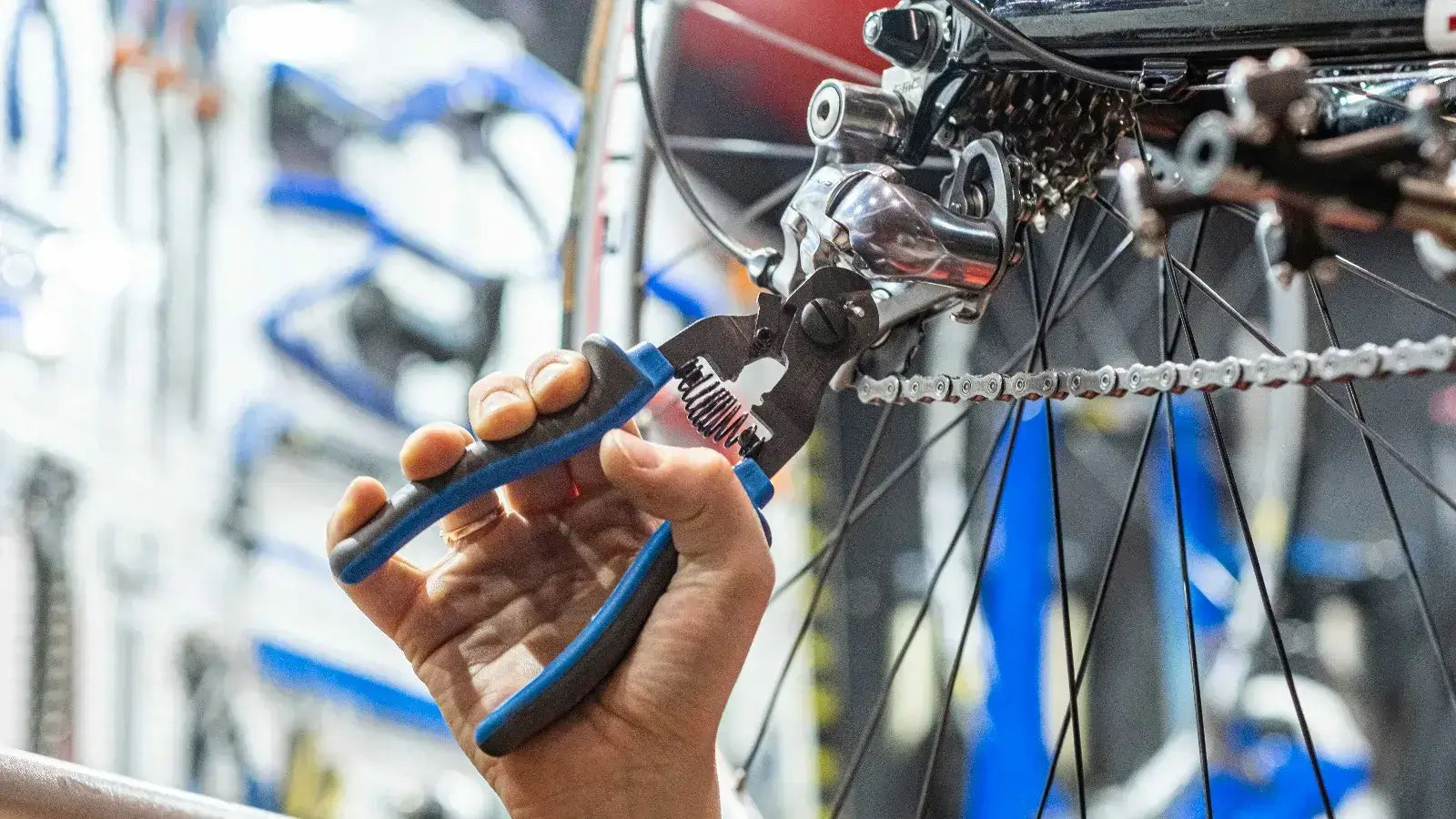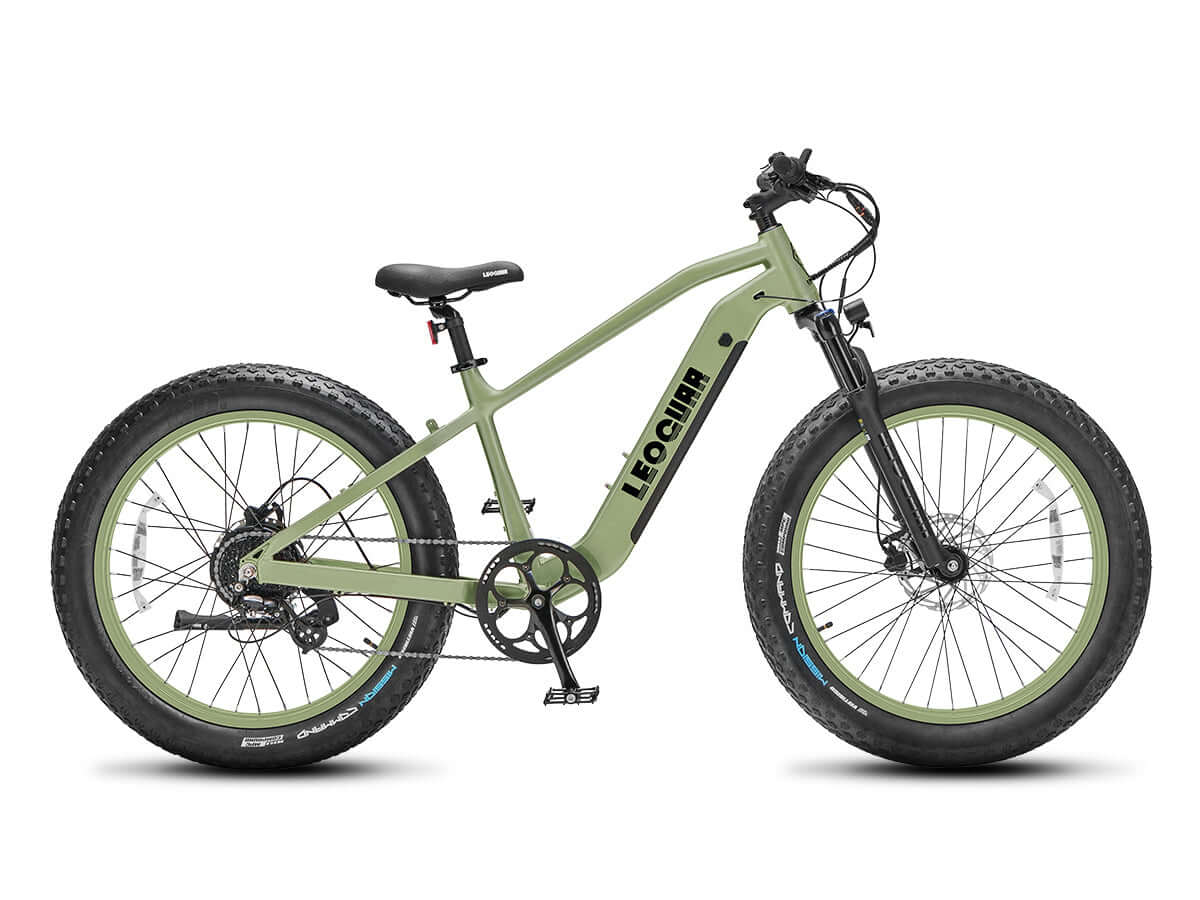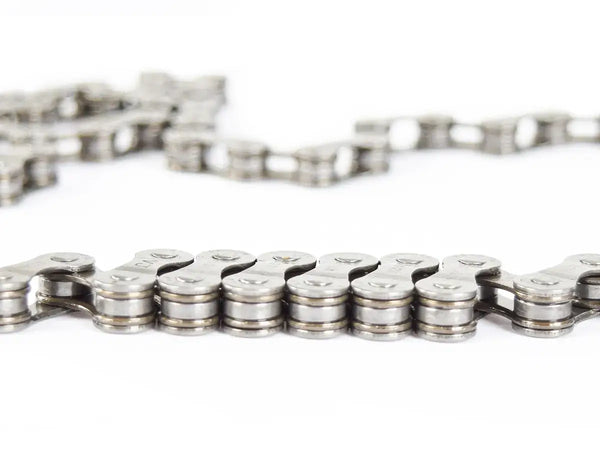
Ebike Chain Knowledge Guide: Why Ebikes Need a Dedicated Chain for High Torque
Why Ebikes Need Special Chains
An ebike chain is different from a regular bike chain. Electric motors create huge amounts of twisting force, especially in mid-drive systems, and this puts stress on the drivetrain that goes way beyond what a standard bicycle chain can handle. This is not just a small detail. It's a major engineering problem that affects your whole bike. Using the wrong chain on a powerful ebike causes much faster wear, poor shifting, and a higher chance of the chain breaking completely. For serious riders, this means more time fixing your bike, higher costs over time, and real safety risks.
This guide comes from years of shop experience and thousands of miles on electric bikes. We will explain exactly why this happens, what makes a dedicated ebike chain different, how to pick the right one for your bike, and how to take care of it properly. Understanding the unique demands on your ebike's chain is the first step to protecting your investment and ensuring a safe, smooth ride for thousands of miles.
The Ebike Power Problem
To understand the solution, we must first understand the problem. The main issue is not speed but the raw, rotational force that an electric motor applies to your drivetrain. This force is called torque. It's the main reason standard bicycle parts wear out too quickly on an ebike.
Understanding Ebike Torque
Torque is the "grunt" or rotational power that gets you moving from a stop and pushes you up steep hills. An average cyclist might create a peak of 40-50 Newton-meters (Nm) of torque in a short burst, but modern mid-drive ebikes routinely deliver a sustained 50Nm to over 90Nm.
This force hits the chain directly every time the motor helps your pedaling. Here's an example we use in the shop: a standard bicycle drivetrain is like the transmission in a small, lightweight car. It's designed perfectly for the power its engine makes. A high-torque ebike, however, is like a powerful truck engine.
If you tried to use the car's transmission to tow a heavy load with that truck engine, the gears and parts would be destroyed quickly. This is exactly what happens when a standard, non-ebike-rated chain is forced to handle the massive torque of a mid-drive motor. The forces are simply too great for the materials and design.
Mid-Drive vs. Hub-Drive Stress
The location of your ebike's motor dramatically changes the stress placed on the chain.
Mid-Drive Motors: These powerful systems sit at the electric bike crankset and apply the motor's power directly through the standard drivetrain—the chain, cassette, and chainring. This means the chain must handle the combined force of your pedaling and the motor's full torque. This is where a dedicated, strong ebike chain is not just recommended but absolutely critical for performance, safety, and durability.
Hub-Drive Motors: These motors are housed within the hub of the front or rear wheel. They apply power directly to the wheel, effectively bypassing the chain for the motorized part of the propulsion.
The chain on a hub-drive ebike only handles the force from the rider's pedaling, much like a non-electric bike. While a stronger chain is always a good idea for overall life span, the extreme forces that require an ebike-specific chain are mainly a concern for mid-drive systems. As many experts note, understanding the critical differences for e-bike specific chains is key to drivetrain health, especially with mid-drives.
Anatomy of an Ebike Chain
At first glance, an ebike chain looks almost identical to a standard one. However, the differences are significant and are found in the materials, manufacturing processes, and engineering details that you can't always see. These improvements are all designed to fight the destructive forces of high torque.
Pins, Plates, and Coatings
The strength of a chain is determined by its weakest link—literally. Manufacturers have strengthened every part of the chain to create a component that can withstand the unique demands of an ebike.
Stronger Pins: The pins are the rivets that hold the entire chain together. They face huge shearing forces from motor torque. Ebike-specific chains use pins made from harder, often chrome-hardened steel. Furthermore, the riveting process is more robust, creating a "mushroomed" head with a wider flare that dramatically increases the force required to pull the plates apart.
Thicker, Stronger Plates: The inner and outer metal plates of the chain are designed to be more robust. They are often slightly thicker and made from higher-tensile strength steel to resist stretching and twisting when under the huge load of a motor starting from a dead stop or powering up a hill.
Advanced Coatings: High-end ebike chains often feature specialized surface treatments. These aren't just for looks. Coatings like nickel-plating or special treatments from brands like KMC (EcoProTeQ) or SRAM (Hard Chrome) increase the surface hardness of the components, reduce friction for smoother operation, and provide superior rust resistance. This is vital for a component that is constantly exposed to the elements and high stress.
| Feature | Standard Bicycle Chain | Dedicated Ebike Chain | Why It Matters for Ebikes |
|---|---|---|---|
| Pin Strength | Standard Hardness Steel | Hardened, Chromed Steel | Resists shearing force from sustained motor torque. |
| Plate Design | Standard Thickness | Thicker, Reinforced Plates | Prevents stretching and twisting under high load. |
| Riveting Process | Standard Peening | High-Strength Mushroom Riveting | Increases overall tensile and pull-out strength. |
| Surface Coating | Basic or None | Anti-Corrosion, Hardening Coats | Improves durability, shifting performance, and longevity. |
Risks of the Wrong Chain
Using a standard, non-ebike-rated chain on a mid-drive ebike is a false savings. While you might save a few dollars upfront, the resulting damage and potential safety risks will cost you far more in the long run. It's not a matter of if it will cause problems, but when.
A Cascade of Failures
A weak chain doesn't just fail on its own. It starts a destructive chain reaction that damages your entire drivetrain.
Accelerated Chain Stretch: This is the first and most common problem. A chain doesn't actually "stretch." Instead, the high torque wears down the pins and the inside of the rollers, causing the distance between each link to increase. A worn chain shifts poorly, makes grinding noises under load, and loses efficiency.
We've seen brand new, non-ebike chains on powerful mid-drive bikes become dangerously worn in as little as 500-800 miles, a fraction of their expected lifespan on a non-electric bike. The grinding sound and the sensation of gears "skipping" under power are clear signs that the drivetrain is suffering.
Damaged Drivetrain Components: This is where the real cost comes in. A stretched chain no longer sits correctly on the teeth of your cassette and chainring. It rides up high on the teeth, and under the motor's power, it acts like a file, rapidly grinding them into a "shark-fin" shape. This damage cannot be fixed. A new, high-quality ebike chain might cost $40-$80. A new high-end ebike cassette and chainring can cost several hundred dollars. Replacing a worn chain before it damages other parts is one of the most cost-effective pieces of maintenance you can perform.
"Chainsuck" and Poor Shifting: As the chain and chainring teeth wear together, the chain can fail to come off cleanly from the bottom of the chainring. It gets sucked up into the frame, causing a sudden and dangerous jam that can damage your chainstay and derailleur.
Safety Hazard: The ultimate failure is a snapped chain. Imagine applying full power to speed up from a stoplight or climb a steep hill, only to have the chain break. The sudden and complete loss of power will cause your feet to fly off the pedals, leading to a loss of balance and a high risk of a serious fall. This is the most compelling reason to ensure your chain is rated for the forces it will handle. As experts confirm, when a chain breaks under power, the results can be extremely dangerous.
Choosing the Right Chain
Selecting the correct chain is straightforward once you know what to look for. It comes down to compatibility with your drivetrain and ensuring the chain is specifically rated for ebike use.
Compatibility is Key
The most important factor is matching the chain to your drivetrain's number of speeds. A bike with a 10-speed cassette requires a 10-speed chain; a 12-speed cassette needs a 12-speed chain. This is because as the number of gears on the cassette increases, the spacing between them gets narrower, and the chain itself must be narrower to fit. Using the wrong speed chain will result in terrible shifting, noise, and faster wear. You can find the number of speeds by simply counting the cogs on your rear cassette.
Look for E-Bike Rated Marks
Top manufacturers like KMC, Shimano, and SRAM have made this easy. They produce specific product lines engineered for the high torque of ebikes.
- KMC: Look for their "e" series chains, such as the KMC e10 or e12. These are clearly marked "E-BIKE" on the packaging and are purpose-built with reinforced pins and plates.
- Shimano: Shimano has developed its LINKGLIDE (LG) technology specifically for the high-wear environment of ebikes. Chains like the CN-LG500 are designed to be far more durable than their traditional Hyperglide (HG) counterparts.
- SRAM: SRAM's chains are generally very robust, but for e-MTB use, they recommend their stronger chains, often designated for their Eagle drivetrains, which are built to handle extreme loads. If the packaging says "ebike rated" or "ebike specific," you are on the right track.
A Note on Budget
A dedicated ebike chain will cost more than a standard chain—sometimes twice as much. Do not view this as an expense. View it as an investment in the health of your entire drivetrain. Spending $60 on a purpose-built chain that protects your $300 cassette and ensures your safety is one of the smartest financial decisions an ebike owner can make.
Maintenance for Longevity
Even the best ebike chain requires regular care to deliver a long service life. A clean, well-lubricated chain runs smoother, lasts longer, and is more efficient, which can even translate to slightly better battery range.
Clean and Lube Regularly
Your chain lives in a harsh environment, collecting dirt and grit that forms a grinding paste. This paste wears away at your drivetrain every time you pedal.
- Clean Frequently: After every few rides, especially in wet or dusty conditions, take two minutes to wipe your chain down with a rag. For a deeper clean, use a bike-specific degreaser and a chain cleaning tool to remove all the old, dirty lubricant.
- Lubricate Properly: Apply one drop of high-quality lubricant to each roller on the inside of the chain. We recommend using an ebike-specific lubricant, as many are formulated with additives that help them stick better under high pressure.
Let the lube sit for a few minutes to penetrate the rollers, then use a clean rag to wipe off all the excess from the outside of the chain. Excess lube on the outside only attracts more dirt.
Master Your Shifting
How you ride has a huge impact on chain life. The motor's power amplifies the stress of poor shifting habits.
- Anticipate Shifts: Shift into an easier gear before you get to a steep hill, not when you are already straining. Shifting under maximum motor and pedal load is the single most stressful event for your chain.
- Ease Off the Power: As you shift, briefly soften your pedal stroke. Most modern mid-drive systems have sensors that detect this and will briefly cut motor power, allowing the chain to move smoothly to the next cog. This technique alone can dramatically increase the lifespan of your entire drivetrain.
- Avoid Cross-Chaining: Try not to use the extreme gear combinations (e.g., the largest chainring in the front and the largest cog in the back). This puts the chain at a severe angle, increasing friction and wear.
Know When to Replace
A chain is a consumable item. Replacing it early is key. Invest in a simple chain checker tool—it's an inexpensive tool that can save you hundreds of dollars. The tool measures chain wear. For most modern drivetrains (10-speed and up), you should replace the chain when it reaches 0.5% wear. If you let it go to 0.75% or beyond, you have likely already caused significant wear to your more expensive cassette and chainring. Checking your chain takes less than 30 seconds and should be done every few hundred miles.

Your Drivetrain's Unseen Hero
The chain on your ebike may not be the most glamorous component, but it is arguably one of the most critical. It is the vital link that transfers the combined power of you and your motor to the rear wheel. Understanding that the huge torque of a mid-drive ebike requires a stronger, purpose-built chain is fundamental to responsible ownership.
By choosing an ebike-rated chain, maintaining it with regular cleaning and lubrication, and practicing smart shifting techniques, you are doing more than just preventing early wear. You are ensuring a quieter, smoother ride, protecting the significant investment in your drivetrain components, and, most importantly, guaranteeing your safety on the road or trail. Treat your chain like the hero it is, and it will reward you with thousands of miles of reliable performance.
Frequently Asked Questions
1. Q: How often should I replace my ebike chain?
A: Most ebike chains should be replaced every 1,500 to 3,000 miles, depending on riding conditions and maintenance. Use a chain checker tool to measure wear - replace the chain when it reaches 0.5% stretch to prevent damage to other drivetrain components.
2. Q: Can I use a regular bike chain on my hub-drive ebike?
A: Yes, hub-drive ebikes can typically use standard bike chains since the motor power bypasses the drivetrain. However, an ebike-specific chain will still provide better durability and performance for the pedaling forces you apply.
3. Q: What's the difference between a $30 chain and an $80 ebike chain?
A: Higher-end ebike chains feature stronger materials, better surface coatings, and more robust manufacturing processes. While the initial cost is higher, premium chains last significantly longer and protect your expensive cassette and chainring from premature wear.
4. Q: How do I know if my current chain is worn out?
A: Signs of a worn chain include poor shifting performance, grinding noises under load, gears skipping under power, and visible stretching when measured with a chain checker tool. If you notice any of these symptoms, inspect and likely replace your chain immediately.
5. Q: Should I clean my ebike chain differently than a regular bike chain?
A: The cleaning process is similar, but ebike chains may need more frequent attention due to the higher forces they endure. Clean every few rides in harsh conditions, use quality bike-specific degreasers, and apply lubricant designed for high-pressure applications to ensure optimal performance.










































Leave a comment